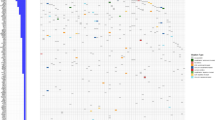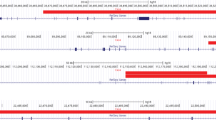Abstract
Despite one third of breast (BC) and colorectal cancer (CRC) cases having a hereditary component, only a small proportion can be explained by germline mutations. The aim of this study was to identify potential genomic alterations related to cancer predisposition. Copy number variations (CNVs) were interrogated in 113 unrelated cases fulfilling the criteria for hereditary BC/CRC and presenting non-pathogenic mutations in BRCA1, BRCA2, MLH1, MSH2, TP53, and CHEK2 genes. An identical germline deep intronic deletion of ROBO1 was identified in three index patients using two microarray platforms (Agilent 4x180K and Affymetrix CytoScan HD). The ROBO1 deletion was confirmed by quantitative PCR (qPCR). Six relatives were also evaluated by CytoScan HD Array. Genomic analysis confirmed a co-segregation of the ROBO1 deletion with the occurrence of cancer in two families. Direct sequencing revealed no pathogenic ROBO1 point mutations. Transcriptomic analysis (HTA 2.0, Affymetrix) in two breast carcinomas from a single patient revealed ROBO1 down-expression with no splicing events near the intronic deletion. Deeper in silico analysis showed several enhancer regions and a histone methylation mark in the deleted region. The ROBO1 deletion in a putative transcriptional regulatory region, its down-expression in tumor samples, and the results of the co-segregation analysis revealing the presence of the alteration in affected individuals suggest a pathogenic effect of the ROBO1 in cancer predisposition.


Similar content being viewed by others
References
Torre LA, Bray F, Siegek RL, Ferlay J, Lortet-Tieulent J, Jemal A. Global cancer statistics, 2012. CA Cancer J Clin. 2015;65:87–108.
Lichtenstein P, Holm NV, Verkasalo PK, Iliadou A, Kaprio J, Koskenvuo M, et al. Environmental and heritable factors in the causation of cancer—analyses of cohorts of twins from Sweden, Denmark, and Finland. N Engl J Med. 2000;343:78–85.
Jasperson KW, Tuohy TM, Neklason DW, Burt RW. Hereditary and familial colon cancer. Gastroenterology. 2010;138:2044–58.
Ghoussaini M, Pharoah PD, Easton DF. Inherited genetic susceptibility to breast cancer: the beginning of the end or the end of the beginning? Am J Pathol. 2013;183:1038–51.
Kuiper RP, Ligtenberg MJ, Hoogerbrugge N, Geurts van Kessel A. Germline copy number variation and cancer risk. Curr Opin Genet Dev. 2010;20:282–9.
Stankiewicz P, Lupski JR. Structural variation in the human genome and its role in disease. Annu Rev Med. 2010;61:437–55.
Krepischi AC, Pearson PL, Rosenberg C. Germline copy number variations and cancer predisposition. Future Oncol. 2012;8:441–50.
Krepischi AC, Achatz MI, Santos EM, Costa SS, Lisboa BC, Brentani H, et al. Germline DNA copy number variation in familial and early-onset breast cancer. Breast Cancer Res. 2012;14:R24.
Pylkäs K, Vuorela M, Otsukka M, Kallioniemi A, Jukkola-Vuorinen A, Winqvist R. Rare copy number variants observed in hereditary breast cancer cases disrupt genes in estrogen signaling and TP53 tumor suppression network. PLoS Genet. 2012;8, e1002734.
Masson AL, Talseth-Palmer BA, Evans TJ, Grice DM, Hannan GN, Scott RJ. Expanding the genetic basis of copy number variation in familial breast cancer. Hered Cancer Clin Pract. 2014;12:15.
Yang R, Chen B, Pfütze K, Buch S, Steinke V, Holinski-Feder E, et al. Genome-wide analysis associates familial colorectal cancer with increases in copy number variations and a rare structural variation at 12p12.3. Carcinogenesis. 2014;35:315–23.
Venkatachalam R, Verwiel ET, Kamping EJ, Hoenselaar E, Görgens H, Schackert HK, et al. Identification of candidate predisposing copy number variants in familial and early-onset colorectal cancer patients. Int J Cancer. 2011;129:1635–42.
Talseth-Palmer BA, Holliday EG, Evans TJ, McEvoy M, Attia J, Grice DM, et al. Continuing difficulties in interpreting CNV data: lessons from a genome-wide CNV association study of Australian HNPCC/lynch syndrome patients. BMC Med Genomics. 2013;6:10.
Brose K, Bland KS, Wang KH, Arnott D, Henzel W, Goodman CS. Slit proteins bind Robo receptors and have an evolutionarily conserved role in repulsive axon guidance. Cell. 1999;96:795–806.
Gröne J, Doebler O, Loddenkemper C, Hotz B, Buhr HJ, Bhargava S. Robo1/Robo4: differential expression of angiogenic markers in colorectal cancer. Oncol Rep. 2006;15:1437–43.
Ito H, Funahashi S, Yamauchi N, Shibahara J, Midorikawa Y, Kawai S, et al. Identification of ROBO1 as a novel hepatocellular carcinoma antigen and a potential therapeutic and diagnostic target. Clin Cancer Res. 2006;12:3257–64.
Sundaresan V, Chung G, Heppell-Parton A, Xiong J, Grundy C, Roberts I, et al. Homozygous deletions at 3p12 in breast and lung cancer. Oncogene. 1998;17:1723–9.
Dallol A, Forgacs E, Martinez A, Sekido Y, Walker R, Kishida T, et al. Tumour specific promoter region methylation of the human homologue of the Drosophila Roundabout gene DUTT1 (ROBO1) in human cancers. Oncogene. 2002;21:3020–8.
Xian J, Aitchison A, Bobrow L, Corbett G, Pannell R, Rabbitts T, et al. Targeted disruption of the 3p12 gene, Dutt1/Robo1, predisposes mice to lung adenocarcinomas and lymphomas with methylation of the gene promoter. Cancer Res. 2004;64:6432–7.
Parray A, Siddique HR, Kuriger JK, Mishra SK, Rhim JS, Nelson HH, et al. ROBO1, a tumor suppressor and critical molecular barrier for localized tumor cells to acquire invasive phenotype: study in African-American and Caucasian prostate cancer models. Int J Cancer. 2014;135:2493–506.
Je EM, Gwak M, Oh H, Choi MR, Choi YJ, Lee SH, et al. Frameshift mutations of axon guidance genes ROBO1 and ROBO2 in gastric and colorectal cancers with microsatellite instability. Pathology. 2013;45:645–50.
Naseem H, Boylan J, Speake D, Leask K, Shenton A, Lalloo F, et al. Inherited association of breast and colorectal cancer: limited role of CHEK2 compared with high-penetrance genes. Clin Genet. 2006;70:388–95.
Umar A, Boland CR, Terdiman JP, Syngal S, de la Chapelle A, Rüschoff J, et al. Revised Bethesda guidelines for hereditary nonpolyposis colorectal cancer (Lynch syndrome) and microsatellite instability. J Natl Cancer Inst. 2004;96:261–8.
Livak KJ, Schmittgen TD. Analysis of relative gene expression data using real-time quantitative PCR and the 2(−Delta Delta C(T)) Method. Methods. 2001;25:402–8.
Quek XC, Thomson DW, Maag JL, Bartonicek N, Signal B, Clark MB, et al. lncRNAdb v2.0: expanding the reference database for functional long noncoding RNAs. Nucleic Acids Res. 2015;43:D168–73.
Kearney HM, Thorland EC, Brown KK, Quintero-Rivera F, South ST, Working Group of the American College of Medical Genetics Laboratory Quality Assurance Committee. American College of Medical Genetics standards and guidelines for interpretation and reporting of postnatal constitutional copy number variants. Genet Med. 2011;13:680–5.
Angeloni D, ter Elst A, Wei MH, van der Veen AY, Braga EA, Klimov EA, et al. Analysis of a new homozygous deletion in the tumor suppressor region at 3p12.3 reveals two novel intronic noncoding RNA genes. Genes Chromosomes Cancer. 2006;45:676–91.
Bovolenta M, Neri M, Fini S, Fabris M, Trabanelli C, Venturoli A, et al. A novel custom high density-comparative genomic hybridization array detects common rearrangements as well as deep intronic mutations in dystrophinopathies. BMC Genomics. 2008;9:572.
Spielman M, Klopocki E. CNVs of noncoding cis-regulatory elements in human disease. Curr Opin Genet Dev. 2013;23:249–56.
Szafranski P, Yang Y, Nelson MU, Bizzarro MJ, Langston C, Stankiewicz P. Novel FOXF1 deep intronic deletion causes lethal lung developmental disorder, alveolar capillary dysplasia with misalignment of pulmonary veins. Hum Mutat. 2013;34:1467–71.
Khelifi MM, Ishmukhametova A, Khau Van Kien P, Thorel D, Méchin D, Perelman S, et al. Pure intronic rearrangements leading to aberrant pseudoexon inclusion in dystrophinopathy: a new class of mutations? Hum Mutat. 2011;32:467–75.
Harland M, Mistry S, Bishop DT, Bishop JA. A deep intronic mutation in CDKN2A is associated with disease in a subset of melanoma pedigrees. Hum Mol Genet. 2001;10:2679–86.
Dehainault C, Michaux D, Pagès-Berhouet S, Caux-Moncoutier V, Doz F, Desjardins L, et al. A deep intronic mutation in the RB1 gene leads to intronic sequence exonisation. Eur J Hum Genet. 2007;15:473–7.
Clendenning M, Buchanan DD, Walsh MD, Nagler B, Rosty C, Thompson B, et al. Mutation deep within an intron of MSH2 causes Lynch syndrome. Fam Cancer. 2011;10:297–301.
Rouleau E, Jesson B, Briaux A, Nogues C, Chabaud V, Demange L, et al. Rare germline large rearrangements in the BRCA1/2 genes and eight candidate genes in 472 patients with breast cancer predisposition. Breast Cancer Res Treat. 2012;133:1179–90.
Kuusisto KM, Akinrinade O, Vihinen M, Kankuri-Tammilehto M, Laasanen SL, Schleutker J. Copy number variation analysis in familial BRCA1/2-negative Finnish breast and ovarian cancer. PLoS One. 2013;8, e71802.
Zentner GE, Tesar PJ, Scacheri PC. Epigenetic signatures distinguish multiple classes of enhancers with distinct cellular functions. Genome Res. 2011;21:1273–83.
Li GM. Decoding the histone code: role of H3K36me3 in mismatch repair and implications for cancer susceptibility and therapy. Cancer Res. 2013;73:6379–83.
Tyner JW, Rutenberg-Schoenberg ML, Erickson H, Willis SG, O’Hare T, Deininger MW, et al. Functional characterization of an activating TEK mutation in acute myeloid leukemia: a cellular context-dependent activating mutation. Leukemia. 2009;23:1345–8.
Mabuchi H, Fujii H, Calin G, Alder H, Negrini M, Rassenti L, et al. Cloning and characterization of CLLD6, CLLD7, and CLLD8, novel candidate genes for leukemogenesis at chromosome 13q14, a region commonly deleted in B-cell chronic lymphocytic leukemia. Cancer Res. 2001;61:2870–7.
Acknowledgments
The authors would like to thank the Nucleic Acid Bank and Department of Pathology of A.C. Camargo Cancer Center (São Paulo, Brazil) and the patients and families who agreed to participate in this study. We are also grateful for the assistance with the sequencing data given by Dr. Felipe C. da Silva.
Author information
Authors and Affiliations
Corresponding author
Ethics declarations
Funding
This study was supported by grants from the National Institute of Science and Technology in Oncogenomics (INCITO FAPESP 2008/57887-9 and CNPq 573589/08-9), FAPESP (2010/15901-5 and 2011/07742-7).
Conflicts of interest
None
Additional information
Rolando A. R. Villacis and Francine B. Abreu contributed equally to this work.
Electronic supplementary material
Below is the link to the electronic supplementary material.
Supplemental Table 1
(XLSX 13 kb)
Supplemental Table 2
(XLSX 10 kb)
Supplemental Table 3
(XLSX 12 kb)
Supplemental Table 4
(XLSX 11 kb)
Supplemental Table 5
(XLSX 12 kb)
Supplemental Fig. 1
Electropherograms showing the silent ROBO1 mutations identified in all relatives tested of patient P2 (P2-2, P2-3, P2-4 and P2-5) (1), in P2-2 and P2-3 only (2) and in P2-4 and P2-5 only (3). (GIF 32 kb)
Supplemental Fig. 2
Hierarchical clustering analysis using the 795 differentially expressed coding transcripts between normal breast and tumor samples. In the heatmap red represents over-expression and blue down-expression. (GIF 28 kb)
Rights and permissions
About this article
Cite this article
Villacis, R.A.R., Abreu, F.B., Miranda, P.M. et al. ROBO1 deletion as a novel germline alteration in breast and colorectal cancer patients. Tumor Biol. 37, 3145–3153 (2016). https://doi.org/10.1007/s13277-015-4145-0
Received:
Accepted:
Published:
Issue Date:
DOI: https://doi.org/10.1007/s13277-015-4145-0




